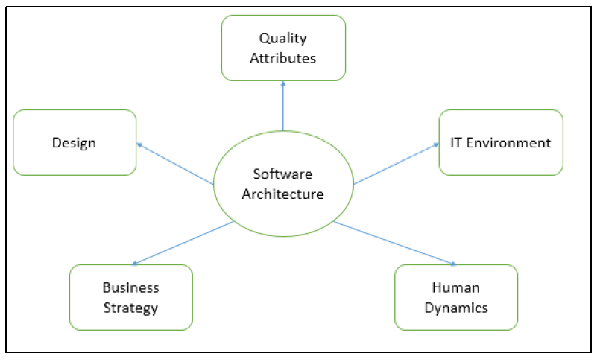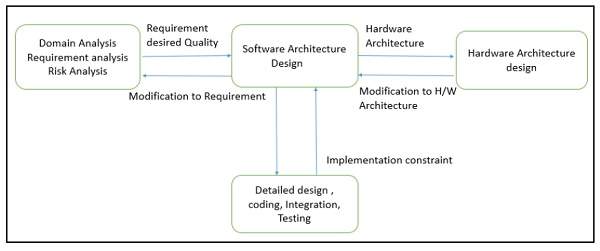The architecture of a system describes its major components, their relationships (structures), and how they interact with each other. Software architecture and design includes several contributory factors such as Business strategy, quality attributes, human dynamics, design, and IT environment.

We can segregate Software Architecture and Design into two distinct phases: Software Architecture and Software Design. In Architecture, nonfunctional decisions are cast and separated by the functional requirements. In Design, functional requirements are accomplished.
Architecture serves as a blueprint for a system. It provides an abstraction to manage the system complexity and establish a communication and coordination mechanism among components. It defines a structured solution to meet all the technical and operational requirements, while optimizing the common quality attributes like performance and security.
Further, it involves a set of significant decisions about the organization related to software development and each of these decisions can have a considerable impact on quality, maintainability, performance, and the overall success of the final product. These decisions comprise of −
Selection of structural elements and their interfaces by which the system is composed.
Behavior as specified in collaborations among those elements.
Composition of these structural and behavioral elements into large subsystem.
Architectural decisions align with business objectives.
Architectural styles guide the organization.
Software design provides a design plan that describes the elements of a system, how they fit, and work together to fulfill the requirement of the system. The objectives of having a design plan are as follows −
To negotiate system requirements, and to set expectations with customers, marketing, and management personnel.
Act as a blueprint during the development process.
Guide the implementation tasks, including detailed design, coding, integration, and testing.
Domain analysis, requirements analysis, and risk analysis comes before architecture design phase, whereas the detailed design, coding, integration, and testing phases come after it.

The primary goal of the architecture is to identify requirements that affect the structure of the application. A well-laid architecture reduces the business risks associated with building a technical solution and builds a bridge between business and technical requirements.
Some of the other goals are as follows −
Expose the structure of the system, but hide its implementation details.
Realize all the use-cases and scenarios.
Try to address the requirements of various stakeholders.
Handle both functional and quality requirements.
Reduce the goal of ownership and improve the organization’s market position.
Improve quality and functionality offered by the system.
Improve external confidence in either the organization or system.
Software architecture is still an emerging discipline within software engineering. It has the following limitations −
Lack of tools and standardized ways to represent architecture.
Lack of analysis methods to predict whether architecture will result in an implementation that meets the requirements.
Lack of awareness of the importance of architectural design to software development.
Lack of understanding of the role of software architect and poor communication among stakeholders.
Lack of understanding of the design process, design experience and evaluation of design.
A Software Architect provides a solution that the technical team can create and design for the entire application. A software architect should have expertise in the following areas −
Expert in software design, including diverse methods and approaches such as object-oriented design, event-driven design, etc.
Lead the development team and coordinate the development efforts for the integrity of the design.
Should be able to review design proposals and tradeoff among themselves.
Expert on the system being developed and plan for software evolution.
Assist in the requirement investigation process, assuring completeness and consistency.
Coordinate the definition of domain model for the system being developed.
Expert on available technologies that helps in the implementation of the system.
Coordinate the selection of programming language, framework, platforms, databases, etc.
Expert on software development methodologies that may be adopted during SDLC (Software Development Life Cycle).
Choose the appropriate approaches for development that helps the entire team.
An architect is expected to deliver clear, complete, consistent, and achievable set of functional goals to the organization. Besides, he is also responsible to provide −
A simplified concept of the system
A design in the form of the system, with at least two layers of decomposition.
A functional description of the system, with at least two layers of decomposition.
A notion of the timing, operator attributes, and the implementation and operation plans
A document or process which ensures functional decomposition is followed, and the form of interfaces is controlled
Besides, facilitating the technical work among team members, it has also some subtle roles such as reinforce the trust relationship among team members and protect team members from the external forces that could distract them and bring less value to the project.
Quality is a measure of excellence or the state of being free from deficiencies or defects. Quality attributes are the system properties that are separate from the functionality of the system.
Implementing quality attributes makes it easier to differentiate a good system from a bad one. Attributes are overall factors that affect runtime behavior, system design, and user experience.
They can be classified as −
Static Quality Attributes − Reflect the structure of a system and organization, directly related to architecture, design, and source code. They are invisible to end-user, but affect the development and maintenance cost, e.g.: modularity, testability, maintainability, etc.
Dynamic Quality Attributes − Reflect the behavior of the system during its execution. They are directly related to system’s architecture, design, source code, configuration, deployment parameters, environment, and platform. They are visible to the end-user and exist at runtime, e.g. throughput, robustness, scalability, etc.
Quality scenarios specify how to prevent a fault from becoming a failure. They can be divided into six parts based on their attribute specifications −
Source − An internal or external entity such as people, hardware, software, or physical infrastructure that generate the stimulus.
Stimulus − A condition that needs to be considered when it arrives on a system.
Environment − The stimulus occurs within certain conditions.
Artifact − A whole system or some part of it such as processors, communication channels, persistent storage, processes etc.
Response − An activity undertaken after the arrival of stimulus such as detect faults, recover from fault, disable event source etc.
Response measure − Should measure the occurred responses so that the requirements can be tested.
The following table lists the common quality attributes a software architecture must have −
| Category | Quality Attribute | Description |
|---|---|---|
| Design Qualities | Conceptual Integrity | Defines the consistency and coherence of the overall design. This includes the way components or modules are designed. |
| Maintainability | Ability of the system to undergo changes with a degree of ease. | |
| Reusability | Defines the capability for components and subsystems to be suitable for use in other applications. | |
| Run-time Qualities | Interoperability | Ability of a system or different systems to operate successfully by communicating and exchanging information with other external systems written and run by external parties. |
| Manageability | Defines how easy it is for system administrators to manage the application. | |
| Reliability | Ability of a system to remain operational over time. | |
| Scalability | Ability of a system to either handle the load increase without impacting the performance of the system or the ability to be readily enlarged. | |
| Security | Capability of a system to prevent malicious or accidental actions outside of the designed usages. | |
| Performance | Indication of the responsiveness of a system to execute any action within a given time interval. | |
| Availability | Defines the proportion of time that the system is functional and working. It can be measured as a percentage of the total system downtime over a predefined period. | |
| System Qualities | Supportability | Ability of the system to provide information helpful for identifying and resolving issues when it fails to work correctly. |
| Testability | Measure of how easy it is to create test criteria for the system and its components. | |
| User Qualities | Usability | Defines how well the application meets the requirements of the user and consumer by being intuitive. |
| Architecture Quality | Correctness | Accountability for satisfying all the requirements of the system. |
| Non-runtime Quality | Portability | Ability of the system to run under different computing environment. |
| Integrality | Ability to make separately developed components of the system work correctly together. | |
| Modifiability | Ease with which each software system can accommodate changes to its software. | |
| Business quality attributes | Cost and schedule | Cost of the system with respect to time to market, expected project lifetime & utilization of legacy. |
| Marketability | Use of system with respect to market competition. |